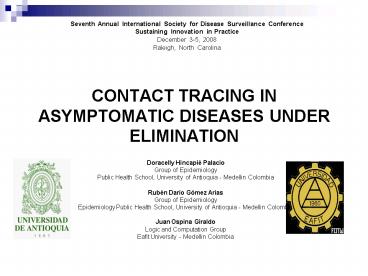CONTACT TRACING IN ASYMPTOMATIC DISEASES UNDER ELIMINATION PowerPoint PPT Presentation
1 / 17
Title: CONTACT TRACING IN ASYMPTOMATIC DISEASES UNDER ELIMINATION
1
CONTACT TRACING IN ASYMPTOMATIC DISEASES UNDER
ELIMINATION
Seventh Annual International Society for Disease
Surveillance Conference Sustaining Innovation in
Practice December 3-5, 2008 Raleigh, North
Carolina
- Doracelly Hincapié Palacio
- Group of Epidemiology
- Public Health School, University of Antioquia -
Medellin Colombia - Rubén Darío Gómez Arias
- Group of Epidemiology
- Epidemiology Public Health School, University of
Antioquia - Medellin Colombia - Juan Ospina Giraldo
- Logic and Computation Group
- Eafit University - Medellin Colombia
2
Contact tracing The public health importance of
an understanding of contact tracing has never
been greater.
WHO. SARS lessons from a new disease.
http//www.who.int/whr/2003/chapter5/en/index.html
PAHO, Regional plan HIV_STI 2006-2015.
http//www.paho.org/english/ad/fch/ai/HIV_Regional
_Plan_2006-2015_ENGLISH.pd
Emergent diseases Severe acute respiratory
syndrome (SARS)
- Increase in sexually transmitted diseases
prevalence
3
CDC. Progress Toward Elimination of Rubella and
Congenital Rubella Syndrome --- the Americas,
20032008. MMWR 2008 57(43)1176-1179
WHO. Polio eradication the final challenge
www.who.int/entity/whr/2003/chapter4/en/
Rubella elimination
Global polio eradication
4
The potential next generation cases are the
primary focus
- How many contacts needs to be successfully
traced and treated to reduce the transmission
probability of the disease? - If we have subclinical infections (but still
infectious)?
5
Objective
- To analyze the critical tracing fraction (fc) to
eliminate disease like rubella when both
asymptomatic and symptomatic individuals are
considered.
6
Methods
Both symptomatic and asymptomatic individuals
- Symptomatic individuals
SIIR model (Susceptible, symptomatic Infected,
Asymptomatic Infected, Recovered)
SIR model (Susceptible, symptomatic Infected,
Recovered)
Analysis of local stability on Maple 11
(Maplesoft Inc)
Basic reproductive rate R0
Measures the average number of secondary cases
generated by a primary case in a pool of mostly
susceptible individuals (Anderson and May, 1991
Brauer and Castillo-Chavez, 2000).
7
Methods
Both symptomatic and asymptomatic individuals
- Symptomatic individuals
SIIR model (Susceptible, symptomatic Infected,
Asymptomatic Infected, Recovered)
SIR model (Susceptible, symptomatic Infected,
Recovered)
Analysis of local stability on Maple 11
(Maplesoft Inc)
Basic reproductive rate R0
The critical tracing fraction fc
The transmission probability of the disease w
8
Method (1)
SIR model (Susceptible, symptomatic Infected,
Recovered individuals)
Infection rate
Mortality rate
?
Natality rate
Susceptible X(t)
Infectious Y(t)
?
?
?
Immunization rate
p
?
q
Recovery rate
Loss of immunity rate
Recovered Z(t)
?
Conditions
t0 X(t), Y(0), Z(0)
9
Method (2)
- SIIR model (Susceptible, symptomatic Infected,
Asymptomatic Infected, Recovered individuals)
Infection rate
Mortality rate
?
Natality rate
?1
?
Susceptible X(t)
Infectious Y1(t)
?
Infection rate (Asymptomatic)
Immunization rate
?2
p
?1
q
Loss of immunity rate
Recovery rate
Infectious Y2(t)
Recovered Z(t)
?2
?
?
Recovery rate (Asymptomatic)
10
Method (3) The basic reproductive rate R0
Analysis of local stability
The disease free equilibrium
Jacobian of the system
Eigenvalues
Threshold for disease elimination
The disease free equilibrium point is locally
stable if
Infection rate
Susceptible individuals
Recovery rate
11
Method (3)
SIIR model (Susceptible, symptomatic Infected,
Asymptomatic Infected, Recovered)
SIR model (Susceptible, symptomatic Infected,
Recovered)
The critical tracing fraction fc
The transmission probability of the disease w
Simulations and sensitivity analysis
Parameters value from Panamerican Health
Organization. Health conditions and trends.
Health in the Americas 2007 Edition.Washington
DC 2007. p. 58-207.
Eames and Keeling (2003),
12
Results
- Parameters value
- (mortality rate 2000-2005) 6x 1000
- q (loss of immunity) 1x10-8
- ?1 (recovery rate symptomatic) 1x10-3
- ?2 (recovery rate asymptomatic) 5x10-4
- p (Immunization rate) 95
55 contacts (90 of 60 contacts per individual)
5 contacts (50 of 10 contacts per individual)
Parameters value from Panamerican Health
Organization. Health conditions and trends.
Health in the Americas 2007 Edition.Washington
DC 2007. p. 58-207.
SIR Model
Transmision probability of the disease
13
Results
- Parameters value
- (mortality rate 2000-2005) 6x 1000
- q (loss of immunity) 1x10-8
- ?1 (recovery rate symptomatic) 1x10-3
- ?2 (recovery rate asymptomatic) 5x10-4
- p (Immunization rate) 95
90 contacts (90 of 100 contacts per individual)
55 contacts (90 of 60 contacts per individual)
10 contacts (50 of 20 contacts per individual)
5 contacts (50 of 10 contacts per individual)
SIIR Model
SIR Model
Transmision probability of the disease
14
Discussion
- Eames and Keeling (2003), deduced the critical
tracing in SIS, SIT and SIR models. - Monitoring of key parameters of the model are
required - Longitudinal studies loss of immunity rate
- Surveillance recovery rate of infected
(treatment, isolation, quarantine, cure)
15
Conclusion
- An increased number of contacts should be traced
to sustain elimination of a disease with
asymptomatic individuals such as rubella when
analysing critical fraction by contacts, a number
of contacts by individuals, and a low probability
of diseases transmission. - A coordinated integrated surveillance and
immunization systems are required.
16
Acknowledgment
- EAFIT University
- Group of Epidemiology at Public Health School,
University of Antioquia.
17
- Many thanks!

